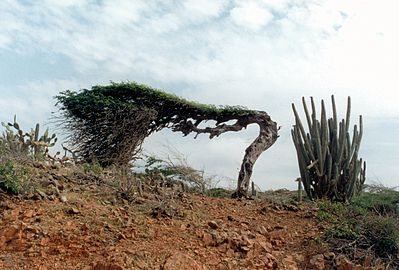The Watapana Tree (Caesalpinia coriaria) is one of Aruba’s most recognizable natural landmarks, often mistaken as the Divi Divi Tree. However, the name “Divi Divi” actually refers to the pods that grow on the tree, while the tree itself is called Watapana. Over time, the two names became interchanged, and today, most visitors recognize it as Aruba’s signature wind-shaped tree.
The Watapana Tree in Aruba is easily identified by its:
For visitors exploring the island, the Watapana Tree always points west, guiding them back toward Palm Beach and Eagle Beach, where the island’s high-rise hotels are located.
Although tannin exports declined, the Watapana Tree is still used in traditional medicine:
The Watapana Tree is more than just a tourist attraction—it is a symbol of Aruba’s resilience and natural beauty. While often called the Divi Divi Tree, its true name remains Watapana, and its distinctive shape continues to captivate visitors.
